How do you rank your photography business in Google?
Are you ready to launch your photography business online—or perhaps to update your online presence for 2020?
Do you find increasing your search engine ranking a daunting task?
Here’s the good news: this SEO guide will help you figure out your next steps without having to stress and obsess over how to handle things like keyword research for the first time. You don’t have to do it alone, because we’ll be here to walk you through the process. To get started, find out why your photography website isn’t showing up in the search results with our SEO Audit Tool, then use this SEO guide to build your search engine ranking!
SEO Basics
Let’s start with the basics—the minimum you need to get your name out there and get your website noticed. Get your 2020 SEO checklist today, and you can also join our Facebook group to get even more insights like the ones mentioned below.
Know-How You Rank
The first step in understanding your search ranking and starting to increase the number of people who will see your website on a regular basis is to set up your search consoles. Most people start with Google since it remains the most important search engine. Check out Google’s Search Console:
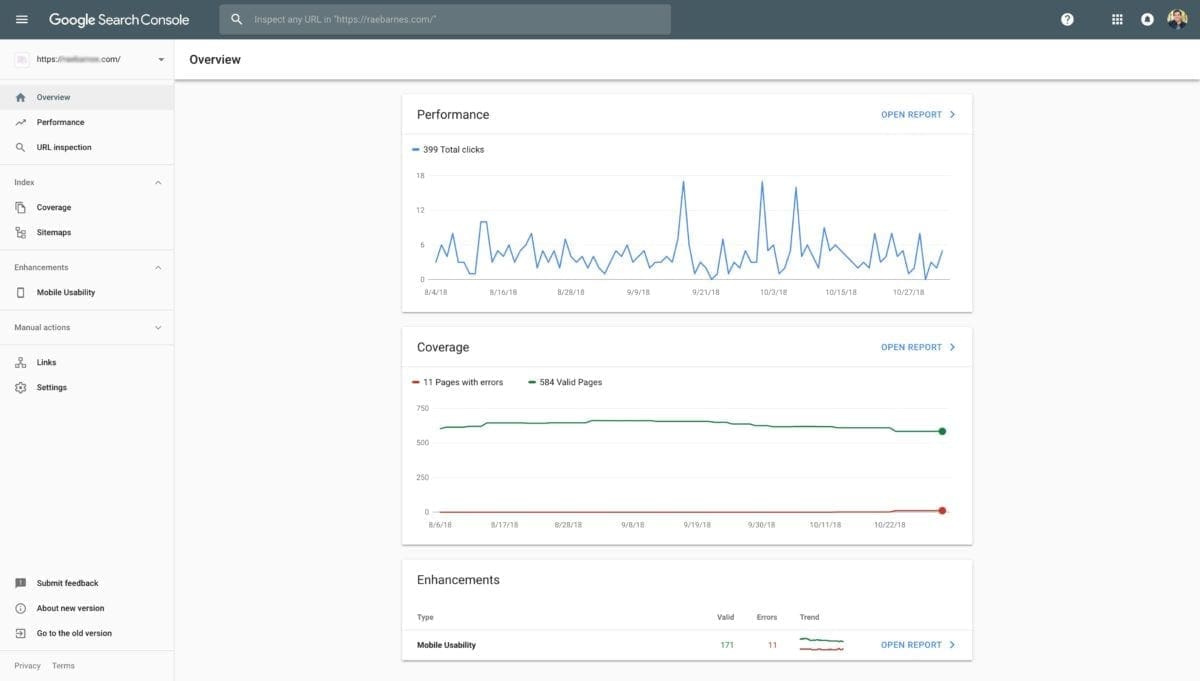
While you’re at it, make sure you have Google Analytics set up and attached to your Search Console. This simple tool offers plenty of features that will help you improve your search ranking and ensure that you know what steps you need to take next.
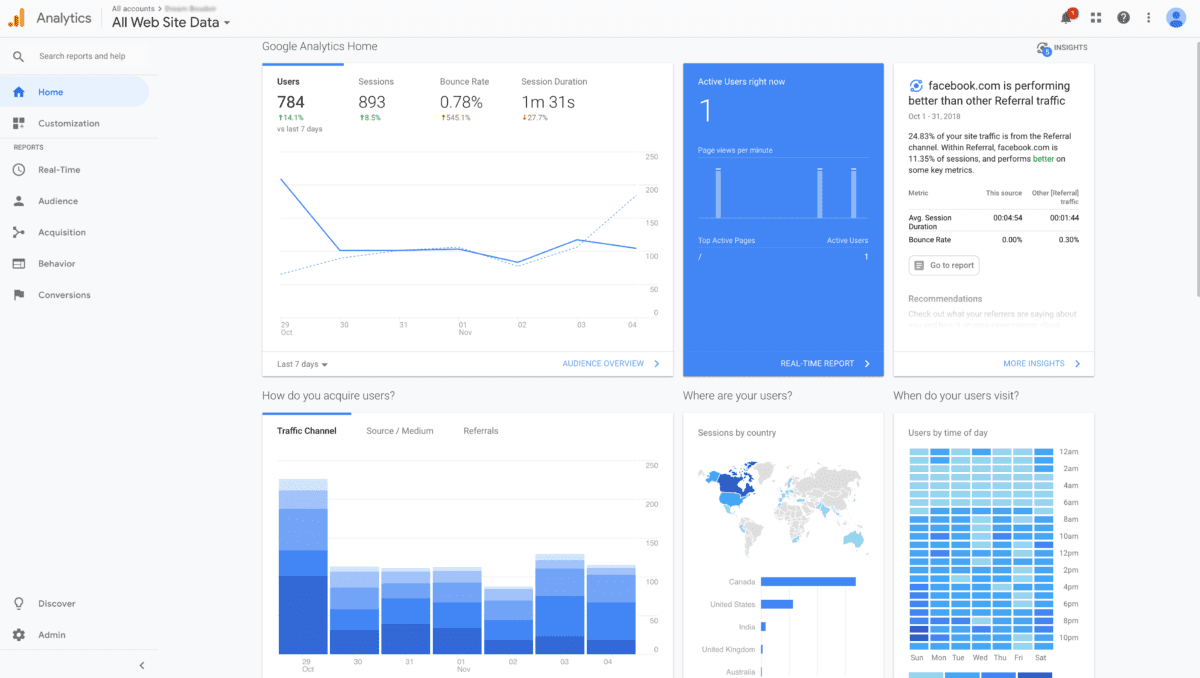
Once you’ve setup Google to your satisfaction, move on to the second most popular search engine: Bing. Around a third of searches are still done on Bing, which makes this a critical part of your SEO plan. Your Bing dashboard is going to look something like this:
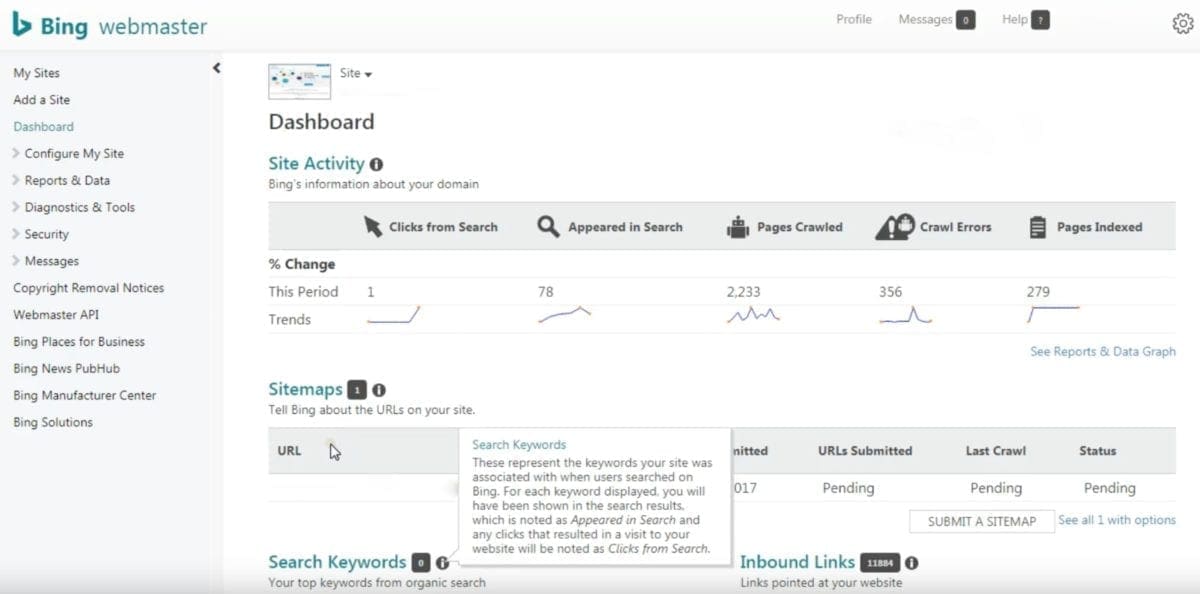
Bing offers several tools that you’ll appreciate, including keyword research directly from your dashboard.
Claim Your Listings
As a business, especially if you have a studio or other physical location, you’ll want to claim your listings through all of the major channels. Your business is yours, and you want to be sure that you’re able to catch any queries about it. Make sure that you claim your listing from:
–Bing
–Yelp
When you claim your listings on the right platforms, you significantly increase the odds that when searchers query information about your business, they’re going to discover your business, not someone else’s—or worse, a blank page. Make sure that you keep these pages up to date, too: any time your contact information changes, from your email address and phone number to the physical address of your studio, if you have one, you’ll need to update your listings.
Discover Where You Need to Rank: Keyword Research
Keyword research: you hear a lot about it when you first start putting together your website and trying to increase your search ranking, but as a photographer, what keywords do you really need to rank for? How do you learn what keywords will actually be useful for your photography business? You deal in pictures, not words, most of the time.
1. Start with your goals. There are plenty of photographers in your area, all of whom have different specialties. What’s yours? Your goals will shape the keywords that are the highest priority for you. For example, if you’re a newborn and family photographer, you’ll want to focus on keywords related to babies, while if you’re a boudoir photographer, you might want to focus on sexy, romance-related photography keywords.
2. Remember your location. As a photographer, you probably work within a relatively select geographic area. It would be great if you had the kinds of clients who were willing to fly you across the country for a one-of-a-kind photo shoot, but chances are, most of your shoots are going to be within a specific geographic radius. You’ll need to highlight local keywords as part of your keyword focus.
3. Think like your customers. When your customers come looking for a photographer, what search terms are they going to use? Imagine that you were looking for a photographer for your skills. Then, use those terms to shape your keywords.
4. Do your research. Check out what keywords competitors in your area are using. While you may not want to use the exact same keywords they are, you don’t want to miss out on key terms and information.
5. Use the tools you have available. Google’s Keyword Planner Tool will give you a great look at important keywords in your industry. Simply input keywords that you’ve thought of, and Keyword Planner will give you a look at how often they’re used, like this:
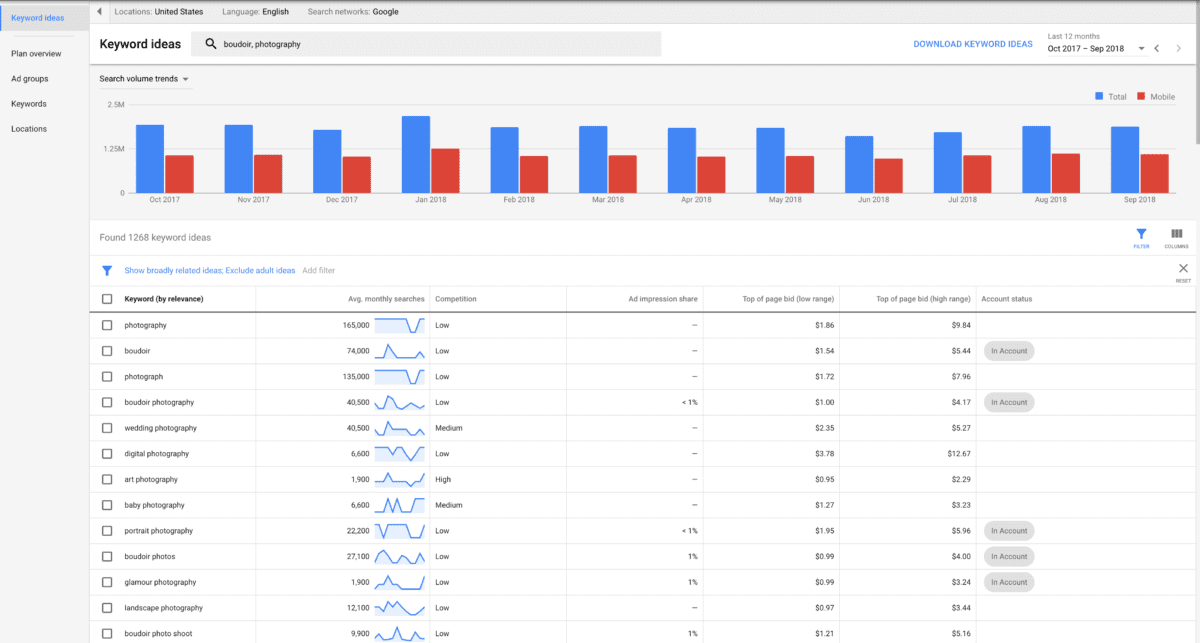
Keyword Planner will also offer you a look at some keywords that you might not yet have thought of, including those that your competitors are less likely to cover—and therefore those that you’ll be in a better position to rank for even from the earliest days of your website.
You can also use tools like Keywordtool.io to help you discover long-tail keywords using keyword suggest options.
- Get to know your audience. Become a part of online communities where customers will share their questions and interests. Take the time to listen to your customers and the questions they ask. This will give you a better idea of the type of content you need to create and, therefore, what keywords will be most important to your potential customers.
Building Your Page
Your website itself will have a great deal to do with your search engine ranking. As a photography website, you’re going to have a heavy focus on images, rather than words—but the words you use will have a significant impact on your search ranking. Consider these important tips:
1. Craft URLs with care. Your URL is one of the key pieces that tells search engines, including Google and Bing, what your page is about. That means that your URL should be as short as possible to help improve your search ranking, and it should include the specific keyword you’re trying to rank for. If you’re creating a page about newborn photography, for example, your URL might be www.yourwebsite.com/newbornphotographyguide or www.yourwebsite.com/tipsfornewbornphotography.
2. Create amazing, rank-worthy titles. Your title is one of the most important pieces of everything you post on your website. Ideally, you want to use your keyword as early in the title as possible, since Google includes the keyword’s location as part of your search ranking. (Of course, that automatically means that your keyword should be included as part of your title.) At the same time, you want your title to give an accurate picture of what the content is about. “10 Ways to Prep for a Newborn Shoot” shouldn’t be an article all about why you’re the best newborn photographer in your area, while “Newborn Photography: What You Need to Know” shouldn’t just be a primer on common newborn poses—or a gallery filled with your images. Instead, let your title showcase the content you’re creating.
3. Take advantage of title tags. Many of your keywords simply don’t fit into the title you’ve crafted. For example, if you’re ranking for “San Francisco boudoir photographer,” you’re not going to create posts like, “Prepping for Your San Francisco Boudoir Photography Shoot.” Instead, take advantage of title tags. By adding modifiers, including terms like “best” or “highly rated,” you can create the search impact without sacrificing your titles. Remember, Google will only display 50-60 characters, so make sure your title counts!
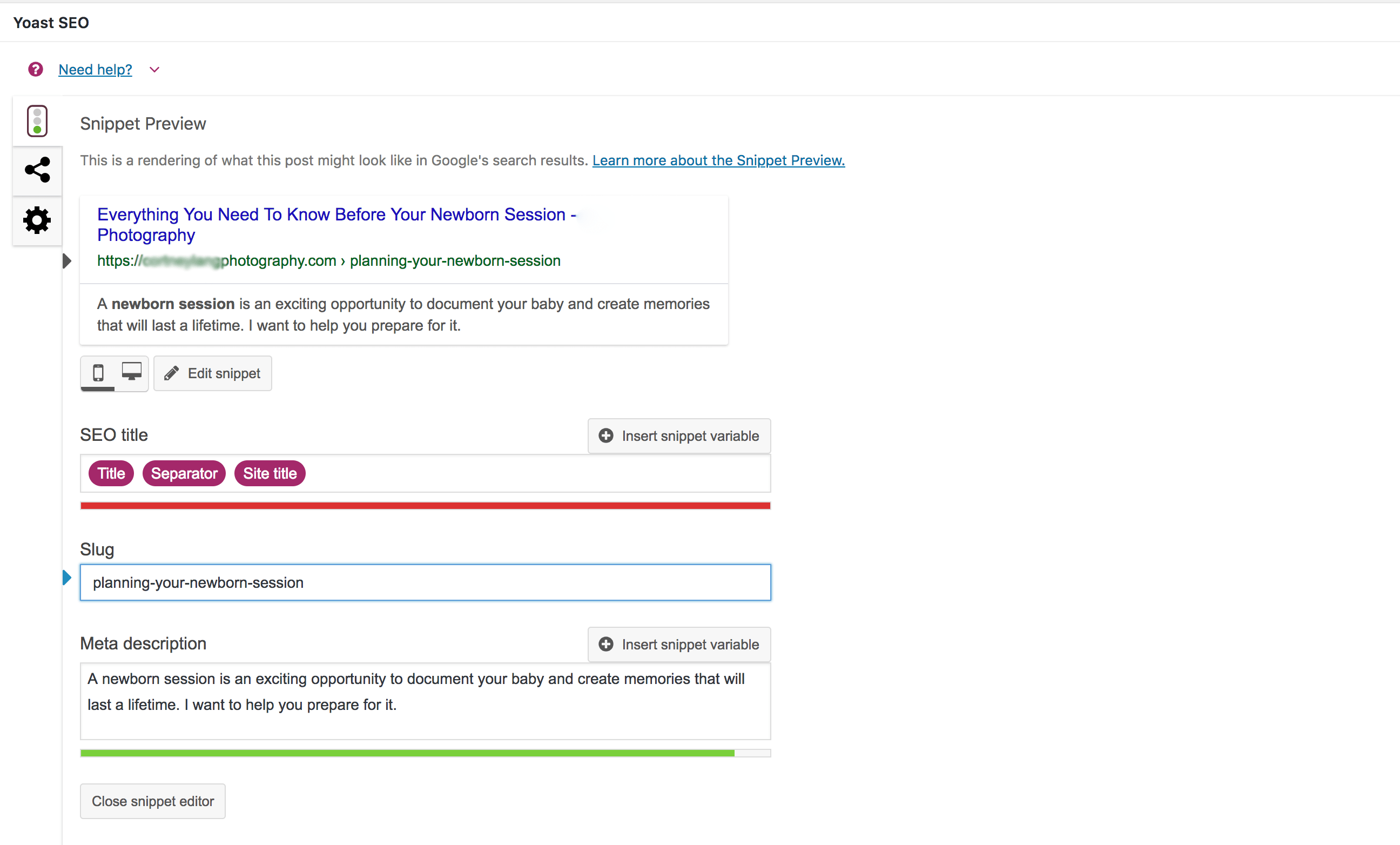
Make the Most of Every Image
As a photographer, you have a lot of images on your page (or, at least, I hope you do). The more you build your page, the more images you’ll end up with as you show examples of your best work and showcase past clients. Those images don’t come with lots of words that Google and Bing can use to evaluate what the page is about—unless you give it to them.
Alternative text for your images is one of the most powerful tools you have for increasing your search engine ranking as a photographer, especially if you don’t have a blog or other content. As you add in alt text, you tell search engines exactly what each picture is about.
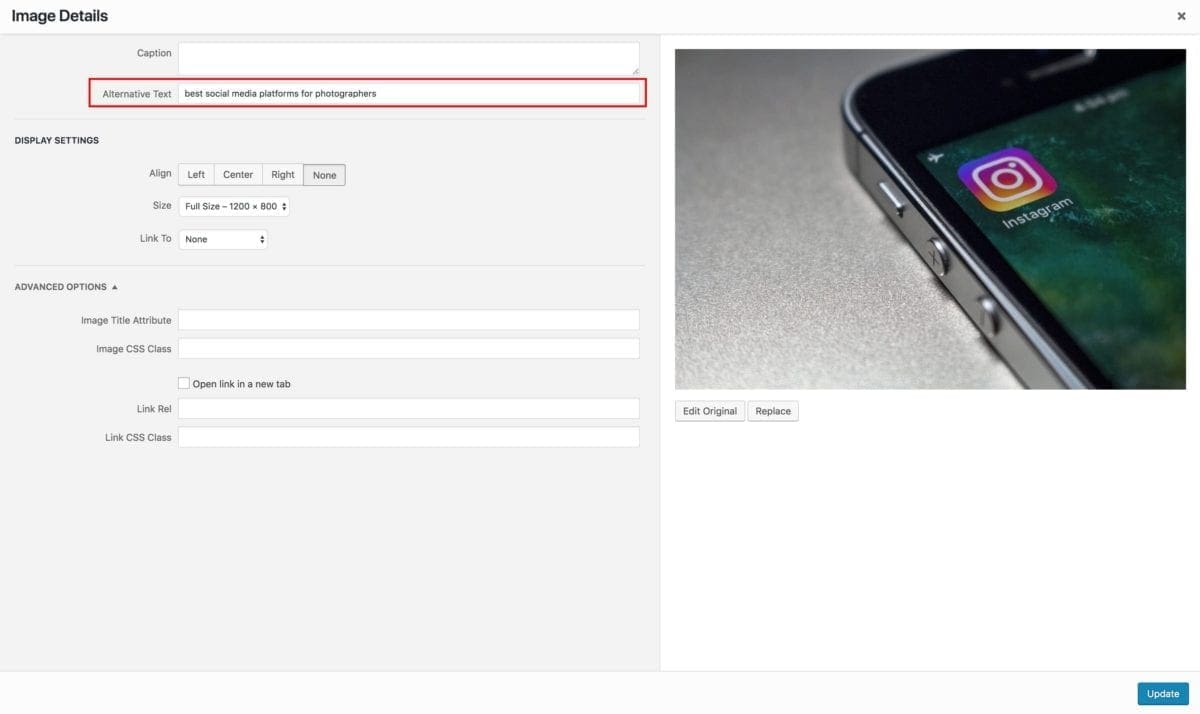
It’s best to be as descriptive as possible as you create your alt text. For example, as a wedding photographer, you might put in a shot of a bride and groom sharing their first kiss—and your alt text should read, “Bride and groom share their first kiss.” Add details about the background if relevant. If you have a picture of the wedding rings, say, “bride’s hand and groom’s hand display their new wedding rings.” Offer information about special features of those rings. The more text you offer, the better search engines will understand your pictures.
Create Fantastic Content
Here’s the thing about search engines: in order to get noticed, you need new, fresh, useful content. You don’t want to create the same content that’s been created by dozens or even hundreds of other photographers; rather, you want to create content that is unique, interesting, and beneficial to your reader.
Search engines can tell when your content isn’t benefitting your readers: you’ll have high bounce rates and pages where no one stays for more than a few seconds. It won’t take long for these pages to drop your search ranking and leave you scrambling to bring attention back to your page. These tips will make your content better and more effective.
- Use keywords carefully. You want to highlight as many keywords as possible across your page. Years ago, keyword stuffing—or cramming as many keywords in each piece of content as you can—helped with SEO. Today’s search engine algorithms, however, are significantly more advanced—which means that you can’t afford to keyword stuff. Instead, use your keywords with care. There are several things to keep in mind with your keywords.
– Use them in H2 and H3 headers. Your headers are important markers in your content. While using your keywords in your headers may only increase your search engine ranking a little, when it comes to SEO, a little can make a big difference.
– Use your keywords as early in your content as possible. Ideally, you want to use them in the first 150 words to grab Google’s attention.
– Check out synonyms for your keywords and make sure that you’re including them as part of your content.
- Make your content count. Every piece of content should actually be beneficial to the person who’s reading it. You want your readers to get something out of what they’re reading, whether it’s a great idea of a photo that they want at their own wedding or a better idea of how to plan for a boudoir shoot. Ask yourself these questions about your content:
– Would you want to read it? That is if you were searching for similar information, would this page be helpful to you?
– Does it answer your readers’ pain points? (Hint: in order to know the answer to this question, you’re going to have to interact with your customers and learn more about them.)
– Is it well-written? Content that’s riddled with errors will leave your customers scratching their heads—or, just as likely, clicking away to something else.
In order to establish how relevant your content is, it’s helpful to use the Skyscraper Technique: find the best piece of content in your field about the topic you’re writing about, then make yours better. For example, is there a comprehensive guide to getting the best pictures for your wedding out there? What can you add to it? How can your experience go beyond the experience of others who have already written on this topic?
3. Make it easy to read. Let’s face it: no one likes to look at huge walls of unbroken text. Instead, break your content up. Use smaller paragraphs, if needed. Use headings, including H2 and H3 headers. Use bold and italics. Add lists. When you break up your content, it’s easier for readers to skim to find exactly what they’re looking for. And, of course, as a photographer, you likely already know that a picture is worth a thousand words—so include them carefully as part of your content.
4. Showcase your expertise. One of the most important benefits of your content is showing what you know. As a photographer, you have experience of a kind that most people don’t get. Most moms only have a couple of newborns that they get to bring in for newborn photo shoots. The average person only has a big wedding once in a lifetime. Make sure that your website provides in-depth coverage of those areas of content. Not only will it help showcase your expertise in your field, but it will also increase your search ranking: Google is more likely to reward sites that show in-depth information about their fields.
5. Go beyond the blog post. Blog posts are great, but they aren’t the only type of content that matters. You already have a rich library of photos to add to your posts. Seriously consider what other types of media might be beneficial. Mixed media helps increase your search rankings while catching the attention of your clients. Consider how you might add videos (behind the scenes looks at a shoot, for example?) infographics and other forms of media to your website.
6. Recycle and refresh content as needed. Your old content isn’t useless. It can go a long way toward improving your search ranking and increasing your online presence—especially if you use it correctly. Take a look at old content and spruce it up occasionally. Add some new images or new tips that experience has taught you. Make sure you don’t have outdated information on your website, from old price lists to old, outdated techniques. This will allow you to make the most of every piece of content on your page.
Building Links
Did you know that the links you have on your site can help increase your search engine ranking? There are two key things that matter: what sites you link back to and what sites link back to you.
The Links You Use
When you choose a link to display on your page, make sure that it follows these key criteria:
– It’s from a reputable source.
– It isn’t broken. (You may need to check your links on a regular basis.)
– It’s to a site that’s relevant.
When you link to reputable authorities in your field, you can piggyback on their authority and help build your search ranking as a result.
Internal Links
Links to your own content can also help build your search engine ranking as well as introducing your visitors to content on your site that might be useful to them in their search. Try some of these techniques:
– Link back to a couple of different pages on each new page you create. Your blog is an excellent place to do this!
– Don’t overdo it. Too many links can make the page look clunky and unprofessional. Instead, stop at around 5 links per page.
– Make sure your links are current and to information that is relevant. Don’t link “newborn photography” back to wedding pictures; instead, focus on content that is relevant to each individual page.
Building Backlinks
Links back to your site are an incredibly valuable search engine tool. When another site creates a link back to yours, they’re saying that they believe that your content is useful and relevant. As a result, Google will push your site higher in the search results. To build great links back to your site, try:
– Creating great content. This will naturally get better links than anything else you can do.
– Partnering with another photographer and linking back to each other’s content.
– Getting involved with other local businesses and linking back to each other. This is a great way to spread the word about your photography business!
– Guest posting. The more you post in other locations, the more traffic you’ll naturally build back to your site. Guest posting will also get you in front of a whole new audience who may fall in love with your photos.
– Get involved in link-building roundups. This simple strategy can help you generate lots of backlinks fast.
Mobile-Friendliness: It’s More Important Than You Think
In 2019, more than half of web traffic originated from mobile devices. You never know when people might be searching for information about your photography business.
If your site isn’t mobile-friendly, then customers who are browsing from mobile devices aren’t going to be able to load it—and they may quickly click away and not come back. Luckily, Google’s Mobile-Friendly Test will tell you whether or not your site is mobile friendly. Discover that it’s not? There are several things you can do to improve the mobile-friendliness of your site.
– Reduce the number of images per page. Images can significantly slow load times. While your galleries may be full of images, you may need to reduce the number of images on other common pages—especially your homepage.
– Skip the popups as much as you can. The more popups you have on your site, the harder it can be for mobile users to get to the content they really want. Where you must have popups, keep them to a minimum—and make sure it’s easy to see how to get rid of them.
– Make sure that the information people look for most is easiest to find. Make buttons large enough to easily click and ensure that people have easy access to the information they need most from you—including details like your portfolio, pricing information, or quick tips for upcoming photo sessions.
– Check out PageSpeed Insights to learn how long it will take your page to load across devices. If you have long load times, it might be time to fix your pages.
Technical Bells and Whistles
As a photographer, you deal with plenty of technical bells and whistles with regards to your equipment on a regular basis. Your website has its own set of bells and whistles that you’ll have to carefully consider in order to more effectively generate the search engine results you’ll need. Check out these important technical details as you’re building your website.
Remember the Google Search Console you set up as part of your first look at your website? Now, it’s going to get some serious use.
1. Check for crawl errors. If you have crawl errors on your page, Google can’t see it well—and that means it’s not going to appear on their rankings. Look on your Search Console under Crawl, then Crawl Stats:

2. Look at how Google sees your page. Open up your search console and go to Crawl, then Fetch as Google.

This will give you an idea of what Google “sees” when it looks at your page. If Google can’t see it, it can’t use it as part of its algorithm—so take a close look at this to make sure that you’re putting your page together properly.
3. Make sure your links aren’t broken. DrLinkCheck.com will let you take a look at your website to ensure that you don’t have any broken links.

4. Increase your security. Don’t just settle for a standard website. Instead, add that important HTTPS distinction. Google prioritizes security for all its users, so you’re more likely to pop up in search engine results if you build your site with HTTPS.
5. Check your meta tags. Duplicate meta tags can decrease your site’s search ranking. Google doesn’t like them. Get back into your Search Console and go to Search Appearance, then HTML Improvements. This will tell you whether or not you have duplicate meta tags and how to fix them.

6. Keep your site up and running smoothly. Downtime makes for unhappy site visitors. Unhappy site visitors don’t come back to your website in the future—and Google will penalize you for downtime. Keep your site up and running smoothly, and fix any errors quickly.
Are you ready to download your SEO checklist?
Building your search engine ranking is an ongoing process for you as a photographer. Every time you complete a new shoot, write a new post or update your website, you have the opportunity to increase your search ranking. By following these key tips, you can keep your business out there and ensure that local families who need photographers will be able to find you when they need you. If you haven’t already, join our Facebook group to learn even more tips and tricks to improve your ranking as a photographer on the web!
P.S. – This piece should likely have been bullet point #1, but don’t forget to optimize your Google Maps so you show up in the Google Location Rankings.
- Verify and claim your business listing on Google My Business. This will allow you to update your business information, such as hours of operation, contact information, and photos.
- Encourage customers to leave reviews on your Google My Business listing. Positive reviews can greatly improve your visibility and credibility in Google Maps.
- Use keywords in your business name, address, and phone number when creating or claiming your listing. These are known as “NAP” (name, address, phone number) and can help Google understand what your business is about.
- Use relevant categories when creating your listing. This will help Google understand what type of business you are and where to place you in search results.
- Add photos and videos of your work to your listing. This can help customers find your business more easily and make your listing stand out.
- Optimize your website for local search by including your city, state, and zip code in your metadata, as well as on your website’s contact page.
- Get listed on other local directories like Yelp, TripAdvisor, and Yellow Pages, this will help your business gain more visibility and increase your chances of ranking well in Google Maps.
- Use structured data markup in your website, it can help Google understand your business better and may show your business information in a more prominent way in search results.
By following these tips, photography studios can improve their visibility and credibility in Google Maps, which can lead to more customers and increased revenue.

Humberto Garcia is the world’s leading photography business growth expert.
Founder of Photography to Profits and high-performance coach to multiple 6-figure photography businesses. Humberto coaches photographers from his special operations military experience and photography sales and marketing experience. After years of high performance in Marine Special Operations and building businesses, he knows what works.








